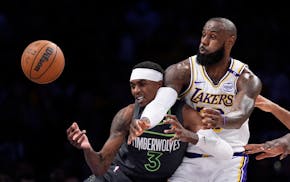Timberwolves President Tim Connelly has said that after 20 games of an NBA season, teams have a good idea of who they are. If that holds true, that would be great news for the 17-4 Wolves, who have the best record in the league.
The Wolves just exited a soft four-game stretch of the schedule and now enter one of their most difficult patches. Between now and Jan. 10, the Wolves will play 16 games, all of them against teams who entered Saturday above .500, with 11 of those games coming on the road.
Their schedule lightens after that, but the next month will be a gantlet — likely their most difficult stretch of the season — and they will see what's real about their early success and what they may need to fix.
Here are some numbers that have gone into contributing to their success, and a few the Wolves may want to improve.
15.7
Net rating for the Wolves in the third quarter, second best in the league.
The Wolves spend the first half much like a snake curling around its prey, and when they are finally in position after halftime, there's no escape for their opponents. This is one of the dramatic improvements the Wolves made from a season ago, when their net rating in the third quarter was -4.4, 23rd in the league.
Then, fans braced for the Wolves to have a letdown after halftime. Now, the expectation is the Wolves make a few adjustments and come out with renewed energy in the second half. This is how they put Friday's win over Memphis away, with a 38-24 third quarter.
106
Defensive rating when Rudy Gobert is off the floor.
Even by his lofty standards, Gobert has been a revelation on the defensive end of the floor. The three-time Defensive Player of the Year didn't receive any votes for the All-Defensive team last season, but now he's the betting favorite to win his fourth DPOY.
There's going to be skepticism that Gobert and the Wolves can keep this up in the playoffs, given that Gobert's Utah teams, which were always highly rated defensively, struggled at times in bad playoff matchups. That may have been because the defenders around Gobert couldn't pull their weight. Look no further than the on-off defensive numbers Gobert's last two Utah teams had. There was a difference of -11.9 in the 2020-21 season for the Jazz's defense when Gobert wasn't on the floor and -7.8 difference in the 21-22 season. For this season? Only -2.
This Wolves team is playing defense at a higher level without him than Gobert's previous Utah teams did, and it's a sign that if Gobert is injured in the regular season, the Wolves can weather that. It's also a sign that the defensive talent, specifically its ability to guard the ball, around Gobert is stronger than his Utah, and some of the worries about him getting played off the floor in a bad matchup might not come to fruition in Minnesota.
18th
Minnesota's defensive rebounding percentage ranking
Improving in this area was a high priority for the Wolves from a season ago, when they were 26th. They have taken steps, but if there's one area the Wolves can stand to improve, it's this. When the Wolves play half-court defense and limit opponents to just one shot, they are one of the toughest teams to play against in the league. They only hurt themselves at times by not cleaning up on the glass.
33.6%
What opponents are shooting from three-point range against the Wolves, tied for third-best in the league.
This is the area of the Wolves' defense where they might be on the lookout for some regression to the mean. There are some who think three-point percentage defense is largely a product of missing shots. But the Wolves might argue that their ability to contest shots on the perimeter is better than most teams, and their defense might play a role in that number. Keep an eye on this if opponents start to shoot better against the Wolves in the future, especially as the quality of teams they face increases.

Live updates: Wolves battle Lakers in first round of NBA playoffs

Orono's Groves will play basketball at Texas Tech

Minnesota United settles for draw against undermanned FC Dallas but stretches unbeaten run to eight games
